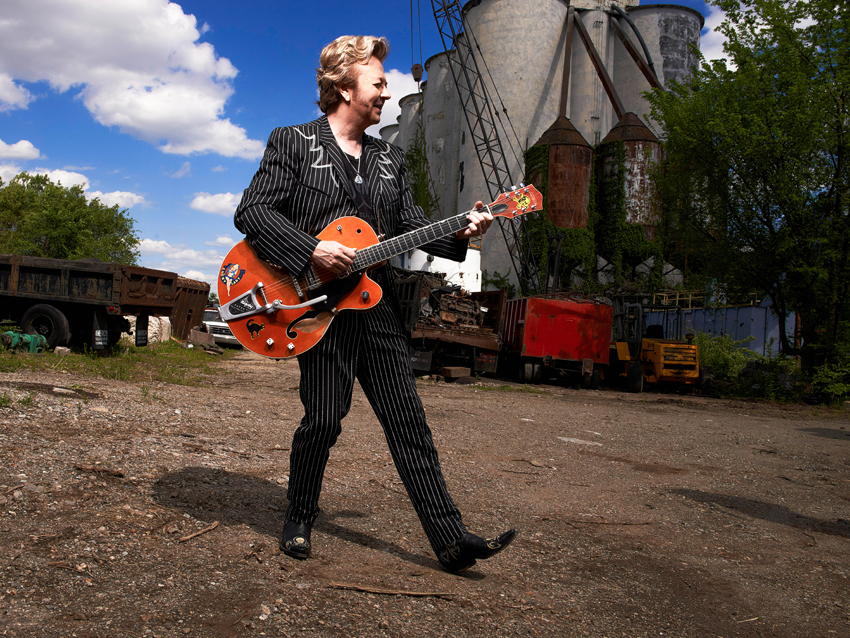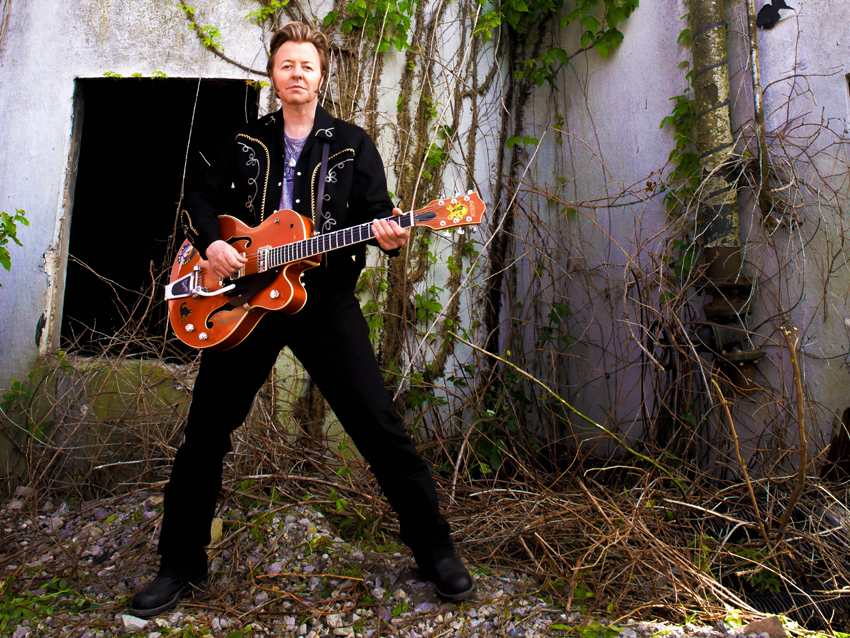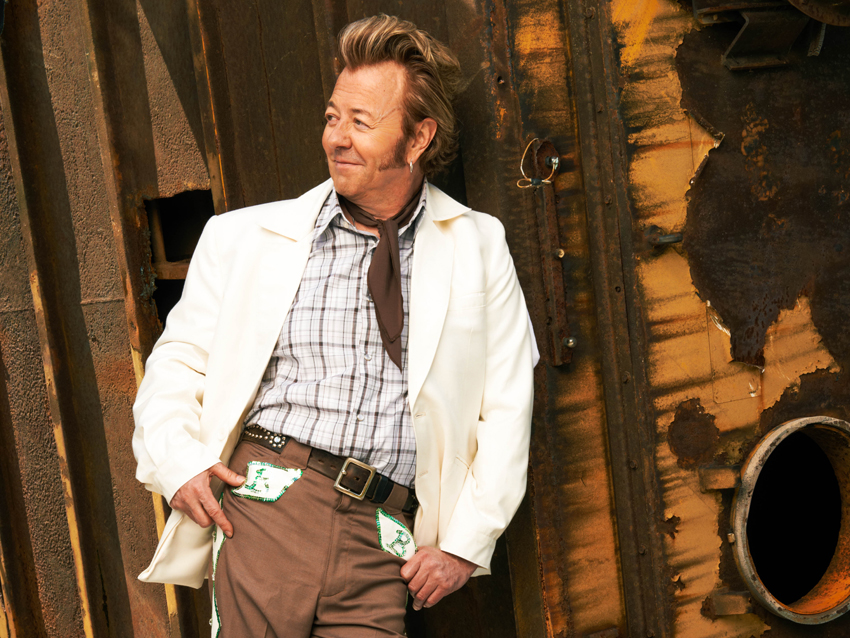
Brian Setzer on his new album, Rockabilly Riot: All Original, track-by-track
“You can really hear the sound of the room on this record," says guitar star Brian Setzer of Rockabilly Riot: All Original, his forthcoming album that features, as the title suggests, 12 all-new tracks of straight-up rockabilly goodness. "We recorded it in Studio A in Nashville, a great-sounding room. Chet Atkins built it in the early ‘60s. Ben Folds bought it and he’s really keeping it the way it was – the microphones, everything. That’s a an expensive deal to do something like that, so hats off to him."
On his annual Christmas-themed tours, Setzer travels with an orchestra of up to 18 musicians; however, when it came time to record Rockabilly Riot, he pared things down considerably, choosing only a trio of players (bassist Mark Winchester, pianist Kevin McKendree and drummer Noah Levy) to back him up.
“I didn't need any more than that tight little group," Setzer explains. "But I did something interesting with them: I arranged the songs, made demos, and then I gave a CD to the guys and said, ‘Learn these songs.’ I wanted them to live with the material for a month, month and a half. I never did that before. A lot of times, you go in and figure things out as you're recording."
Rockabilly Riot: All Original marks Setzer's third time in the studio with producer Peter Collins, who also helmed the guitarist's The Dirty Boogie (1998) and Vavoom! (2000). Although primarily known for his work with progressive rock bands such as Rush and Queensryche, the British-born Collins, says Setzer, has rockabilly in his blood. "He's lived in Nashville for 20 years, so that, of course, helps. Peter's kind of like Dave Edmunds, who's also English – he gets rockabilly. The British guys seem to know how to capture the rockabilly spirit in a way that a lot of Americans don’t. It’s like how the Stones and those bands caught on to the blues. American music jumped ship and went over there.”
Coming off his latest Christmas tour, Setzer had a guitar-and-gear setup that was "just hummin'," and he wasn't about to mess with it when he hit the studio: "I had my '59 Gretsch [6120], a ’63 Fender Bassman and the Roland Space Echo, and everything sounded great," he enthuses. "I said, ‘Let’s get this stuff to Nashville and plug it all in – it’s working.’ Because that always happens: I’ll try out some crazy little tape echo, some weird little pedal or whatever, and then I’ll always go back to the same gear. You stick with what works."
Only on one track, What's Her Name, did Setzer veer from his tried-and-true combination: “On that song, I used an old Maganatone amp, like the kind Buddy Holly used to use. I wanted a certain kind of vibrato for that song, and those old Magnatones have just the right sound.”
Come November, Setzer and his full orchestra will embark on another Christmas Rocks Extravaganza, but the guitarist is hot on the idea of playing the new record live. "That's the next step, playing this album on stage," he says. "Even if it's just a club tour, I've gotta get out there with the band and play the record. I'm thinking next spring, after the Christmas tour."
Brian Setzer's Rockabilly Riot: All Original will be released on August 12 through Surfdog Records.You can pre-order the CD here and the vinyl edition here. On the following pages, Setzer walks us through the album track-by-track.

Let's Shake
“It’s a cool rave-up. For me, it’s all about getting that guitar to sound just the way I want it; I really am happy when I hear it back along with that 1928 Steinway baby grand piano. What a sound!
“I stand corrected, though: I thought I was the first guy to write a song called Let’s Shake. Turns out there was a band in the ‘80s, Teenage Head, and they had a song with the same title. I don’t know the band at all – I have no idea what they were all about. So I’m the second guy to have Let’s Shake, which isn’t so bad.
“I thought it was pretty original-sounding title, sort of something Jerry Lee Lewis would call one of his songs. But he never would have had those guitars.”

Rockabilly Blues
“It’s a song about me and my guitar. I got me this guitar, it cost me a hundred bucks, and look at how far it’s brought me. Truth is, I can’t believe I even got out of the garage, you know what I mean? After all these years, I’ve still got the same guitar. It’s turned out to be my best friend.
“It’s me doing my crazy version of rockabilly on the guitar. The song has a great slap bass solo by Mark Winchester, and a terrific little drum solo. The whole thing’s pretty hot.”

Vinyl Records
“It’s the first song I wrote for this record, and it was actually inspired by my daughter. She had those little peas in her ears and was listening to something on her iPad. ‘Lemme hear that,’ I said, and sort of yanked them out of her ears. ‘Sounds like crap,’ I told her.
“She looked at me and said, ‘Oh, Dad, you just don’t like the band.’ I told her, 'That’s not it – it's got nothing to do with the music. It just doesn’t sound good. Here, listen to this.’ She likes classic rock and new bands I’ve never heard of, so I cranked up my old ’63 Mcintosh stereo. When she heard what I was playing, she went, ‘Oh, my God!’ [Laughs] It was amazing, that feeling – ‘Dad did something cool.’ It was the spark that got the sound going.
“For Christmas, we got her a stereo, and now she hunts down vinyl records with her friends. She’s got the original London Calling, original Zeppelin, all kinds of cool stuff.
“The song came out great. I came up with this neat lick for the first solo. It’s so simple, like a Chuck Berry riff. That’s the other thing that got me going on the song. I love that moment when something pops out of your fingers and you go, ‘I got a riff! I got a riff!’ – nothing like it.”

Lemme Slide
“This is me saying to a police officer, ‘Please, officer, lemme slide…’ [Laughs] That’s kind of my life story with everybody: ‘Lemme slide. I made a mistake.’
“There’s a lot of fun, unexpected rockabilly changes in this one; it’s not a I-IV-V thing. I’m knew that I needed something good for the first lead solo it – it’s got some jazz things going on it. I think I sat down and really figured it all out. Some things are spontaneous, but every so often you have to plot out your moves."

Nothing Is A Sure Thing
“Man, I wish I’d put a little more reverb on the guitar. On this song, I’m out of the ‘50s and into the ‘60s. That riff is a pure danger riff. Hittin’ the flat-5, I thought, ‘Wow, that’s really cool.’
“The thing that made the distinction was when Peter Collins came up with that double-stop at the end: [Sings] ‘When trouble rolls around – ba-ba-bum-bum-bump! And then you’re layin’ low – ba-ba-bum-bum-bump!’ That’s what a good producer will do. He’ll always go for that thing you don’t have, that extra idea.
“It’s such a cool riff. Damn, I just wish I had that reverb crankin’. But you know how it is – you touch one thing and then everything changes.”

What's Her Name
“Some people hear a little Eddie Cochran in there, and that’s fine by me. Eddie’s always in there, as far as I’m concerned. He’s my guy, my hero.
“I wrote this one about a guy who pretends not to care. ‘Oh, yeah, yeah. I used to go out with what’s her name. I think maybe I’ll go looking for her.’ We’ve all known guys like that, and of course, you can see right through them. ‘Remember what’s her name?’ he ask, and you know darn well he knows her name.
“Musically, it’s got some cool stops in it. Yeah, there’s definitely some Cochran in it, which is a good thing.”

Calamity Jane
“I love old westerns. Slim Jim and I used to watch Gunsmoke, and we’d be like, ‘Look at the clothes on that guy. Imagine wearing something like that.’ I got to thinking of that period. Again, like with Let’s Shake, I thought, ‘Hey, nobody’s used that name – Calamity Jane.’
“So the title came first and everything else followed. I pictured Calamity Jane in an old saloon, on top of the piano, with the poker game and the gun fight. The song has the rockabilly fingerpicking, but to make it different, I thought, ‘Let’s do an old-fashioned bluegrass stack.’ [Sings] ‘Calamity Jane – Jane – Janneee.’ That’ll really throw a curveball in there. We’ll see how that works live.
“I tried to make the solo a little nasty. If a rock band were playing the song, they’d probably do it more single note. Rockabilly calls for more fingerstyle. That’s just how I hear it.”

The Girl With The Blues In Her Eyes
“I started strumming that D chord, and instead of going to a G or an A, I went to a D minor chord. ‘Wow, that’s kind of unique,’ I thought. If you catch those little pieces of magic, they’re like a gift. Then it’s your responsibility to finish the song and not waste the gift, you know?
“My friend Mike Himmelstein wrote the lyrics, but originally he was calling the song something else. When I saw the line about ‘the girl with the blues in her eyes,’ I said, ‘No, no, no, Mike. That’s our title.’ You can’t just throw that away in a lyric.
“I was thinking of sort of a Cliff Gallup guitar sound on this, just nice and clean. It’s kind of a chordal-type solo, which felt right. If you have a well-written song, sometimes just a guitar through an amp is all you need. It sounds ridiculous to say, but it’s hardly done anymore. Everybody has a spaceship in front of them when they play.”

Stiletto Cool
“I had that progression, those dark chords just going together. They so worked with the words – [sings] ‘She’s got the look I like/ she’s one I want/ she’s got a high dress on/ and her high feels on.’ It’s a rockabilly riff, but I don’t think it’s anything I’ve heard.
“That’s what starts it, the riff. In the ‘50s, they would’ve played the blues around it. But I decided to update it so that it’s not just a retread. Those choruses really make it sound new.
“The solo is pretty hot. It’s a crazy-ass minor-major chord thing. People are going to ask me how to play that one. It’s something you’d hear a jazz guy do, but I rocked it up. It bends your ear.”

I Should Have Had A V8
“I still like the old car thing. And the truth is, I’m the kind of guy who likes to get there fast. I bought a new car with a V6, and I hated it. There was no power at all. I was like, ‘Damn! I should’ve got a V8’ – and then it stuck in my head. It’s a tongue in cheek thing, of course.
“The song changes up. It does that Johnny Horton Battle Of New Orleans thing, which harkens back to another era, the Civil War. Then it goes into a swing and takes off. I like the tone on the solo – it’s more ‘billy’ than ‘rock.’ I turn up the echo and turn down the amp. You really hear the delay that way.”

Blue Lights Big City
“I couldn’t believe it when I heard those background vocals played back the first time. That was Peter’s idea, and I said, ‘Sure, give it a shot.’ He brought in one guy to do the whole thing, and it worked. To me, it sounds a bit like a Marty Robbins song, like on Gunfighter Ballads And Trail Songs.
“Sometimes I’m just lettin’ it rip on a solo. I’m open to whatever comes out – here it comes, whatever it is. On this one, I think I’m quoting other guys more; I’m doing a more Chet Atkins-Scotty Moore thing with the fingerpicking. It harkens back to some of their feel.”

Cock-a-Doodle-Don't
“I wrote 14 songs and we picked 12 to record. Mark Winchester wrote a song called Rooster Rock. Fans always loved that one. Thing is, I had to tell him, ‘Mark, I wrote a song called Cock-a-Doodle Don’t. It’s a little close to Rooster Rock as far as the title goes. Is that OK with you?’ And he said, ‘Brian, any song about barnyard animals is fine with me.’ [Laughs]
“This is a great example of a solo I just played off the top of my head. There’s no overdubs, no splicing – I’m in there tearin’ it up. It’s live music. It’s interesting, though: We start on a rave-up and end with one. It wasn’t by design; you just put the songs together the best way that you can. There’s always surprises like that when you make a record.”
Joe is a freelance journalist who has, over the past few decades, interviewed hundreds of guitarists for Guitar World, Guitar Player, MusicRadar and Classic Rock. He is also a former editor of Guitar World, contributing writer for Guitar Aficionado and VP of A&R for Island Records. He’s an enthusiastic guitarist, but he’s nowhere near the likes of the people he interviews. Surprisingly, his skills are more suited to the drums. If you need a drummer for your Beatles tribute band, look him up.
